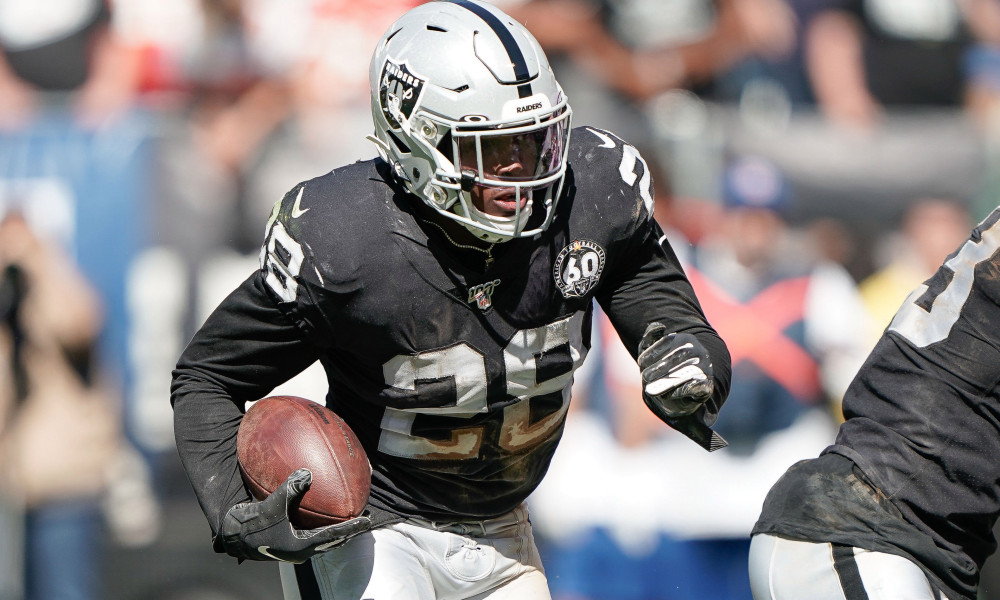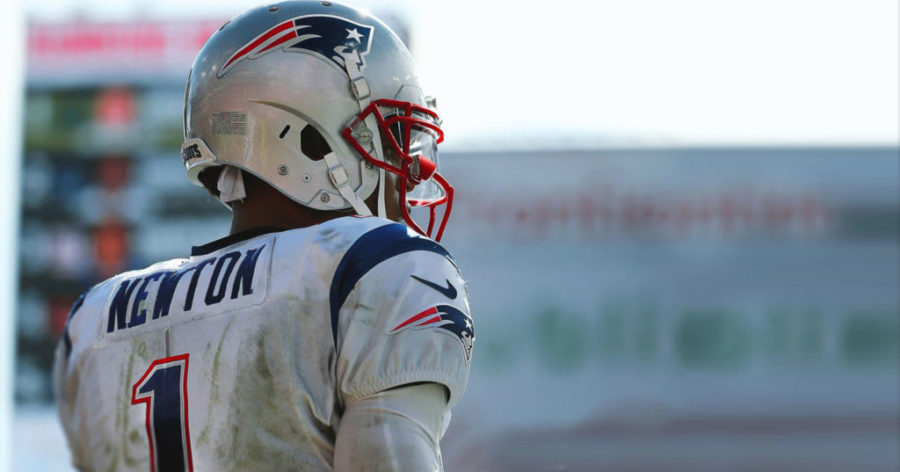NFL Game Scripts Week 3: Las Vegas Raiders @ New England Patriots
With a new QB under centre for the Patriots, and the Raiders moving to a new city, both Las Vegas and New England are looking for more consistency after the first few weeks. Despite starting 2-0, the Raiders still look like they are the little brother to their divisional rival, Kansas City Chiefs. The Patriots, going 1-1, similarly look like they are the second team in their division for the first time in a while, playing catch-up with the Buffalo Bills. As a result, the Raiders and Patriots not only need a win to keep their divisional hopes alive, but also to earn a tiebreaker in the Wild Card race.
Las Vegas Raiders Offense vs. New England Patriots Defense
The Run Game

Las Vegas are in the minority in the NFL in that they use a singular lead back. With Josh Jacobs, they can have him on the field for all three downs, and run him against any weak spot of the defense. Against the Patriots, the Raiders will continue to run both inside and outside the Tackles to see which yields more success. The Raiders will use a combination of 11, 12 and 21 personnel based on situation.
In singleback formation, the Raiders allow themselves to use Jacobs as a receiver in the flats, as well as in the zone-based run scheme. They will use some of these runs early on, so that they can hide Jacobs as a receiver later in the game if they need to pass the ball more. Having Jacobs run up the middle early on not only sets up fake handoffs and play action later on, but reduces the need for Derek Carr to pass too often, and Las Vegas can thus avoid the dominant secondary of the Patriots.
Early in the game, and if they can establish a lead, the Raiders will use 2 TE sets, or 1 TE with a FB at times. Their use of FB Alec Ingold is generally having him in a strong-I formation, and allows Jacobs to follow him to the outside or cut back inside if that’s where the hole is. With 12 personnel, the Raiders vary between lining both TEs up on one side, and splitting them to either side of the OL. With the dual TEs split to either side the Raiders can run Jacobs in either direction, preventing the Patriots from stacking the box on one side more than the other. With the 2 TEs together, Las Vegas can again create extra holes, and give Jacobs options as to which rushing lane he follows. This will be their approach over the second and third quarters, as they seek to continue piling on points, as well as controlling the clock. If they have success, Las Vegas will continue using extra blockers into the 4th quarter, unless they fall more than one score behind.
To counteract this, the Patriots will rotate through their LBs to keep them fresh, and focus on containing Jacobs to have him run up the middle. The Patriots’ DTs Lawrence Guy and Adam Butler will line up in the A-gap, with LBs Chase Winovich, Brandon Copeland and Shillique Calhoun mostly sitting just outside the DEs. Forcing Jacobs to run up the middle allows the Patriots to keep their Safeties in the middle, and try to restrict Jacobs to minimal gains. If this doesn’t work, the Patriots may instead choose to condense their LBs and line them up over the gaps between the DL, and firing through the middle. Either way, the Patriots should seek to allow Jacobs to run to the outside, and force him out of bounds, so that he runs laterally and not downfield, where there will be gaps if he hits the second level.
The Passing Game
The Raiders’ passing game is built around spread concepts with the WRs. The frequently use 3 WR sets, or at times 2 WRs and Darren Waller as a receiving TE. Either bunching the WRs on one side, or moving one WR to each sideline, allows them to have one of their receiving options run towards each sidelines on slants, curls or out routes, with another an in route or curl towards the middle. This then allows them to use their fourth receiving option, either a WR or Waller, on a deeper in route or downfield vertical fade or post. With variations of this used throughout the game, QB Derek Carr can throw into the path of one of his receivers, leading them towards the outside if the coverage is on the inside, or throw over the middle if the coverage is covering the sidelines instead.
While the Raiders will often send a receiver deep, they take few shots downfield, and will take even fewer against the New England secondary. Instead, using the second TE, FB, or Jacobs, Carr will throw short underneath routes, especially on 3rd down with 3 yards to go. Early in the game the Raiders will be happy to settle for short gains, and take a few shots deep if they’re there. But as the game goes on, there may be increased use of play action to give Henry Ruggs and Waller extra time to get separation on intermediate routes.
New England will use their CBs in man coverage on the outside, and should have success in disrupting passes, while also trying to force Carr to make precision sideline throws. Their nickel CB JC Jackson will be used to defend both the slot receiver and Waller at times, although leaves the Patriots exposed to Jacobs running to the outside.
Their Safeties will both be at the line of scrimmage more to defend against Jacobs, although they may at times be matched up against Waller, allowing the Patriots to bring another pass-rusher. New England could attempt to disguise their coverage by dropping different players back as a single high Safety, but will have difficulty finding the right alignment early in the game. However, by the second half, New England will use less nickel defense, so that they can attack the OL more to either get to Jacobs early, or increase their blitz.
What should we expect to see on Sunday?
The Raiders will run early and often. Unless they start falling behind early, we should see them run for over 60% of their plays, and then use this to chew clock and set up play action. Las Vegas will spread their receivers out across the field, taking few deep shots, while moving the ball on short plays. New England will need to target Jacobs as a runner and receiver at the risk of big plays to the outside or increased space in the passing game. However, the Patriots will need to bring in bigger defenders as the game continues in trying to beat the OL, even if it means having less to offer in pass coverage.
New England Patriots Offense vs.Las Vegas Raiders Defense
The Run Game
New England’s rushing attack has changed this season, given their ability to run option plays with Cam Newton. They use multiple backs frequently, and allow Newton to run with the football throughout the game. The Patriots will run Newton to the outside instead of up the middle, especially in the first half, so that the Raiders are forced to sit back and wait for him to make his read. This will allow space to open up through the middle as defenders are forced to cover the outside.
With their RBs, the Patriots will line up in I-formation and wingbacks, using Sony Michel, Rex Burkhead and James White in different ways. Michel and White can be split out as receivers at the LOS, or remain as a receiver out of the backfield. This then allows the second back to either take the handoff and run up the middle on dives or counters, or get to the outside with toss plays. To further disguise their run plays, the Patriots will also fake handoffs to one of the RBs, and move TEs from one side of the OL to the other to act as a blocker. A majority of their runs will be between the Tackles, but with the option plays early on, and RBs as receivers out of the backfield, including toss plays, the Patriots will simulate a run game throughout all four quarters.
The Raiders have a strong DL, and will likely use extra linemen to restrict rushing lanes up the middle. Bringing Maurice Hurst and Clelin Ferrell to the interior will keep Maxx Crosby and Arden Key on the outside, with rotation on the edge with LBs. From this base formation, the Raiders can funnel runs up the middle, taking away Newton as a rusher, while using Safeties and LBs to cover the RBs, regardless of where they move. Although Michel may find space through the middle, the Raiders can force the Patriots OL into one-on-one matchups and thus have LBs sitting over the top of the Guards and plugging the A and B gaps.
The Passing Game

New England are still determining how best to use their WRs, but could test the Raiders’ CBs in Week 3. While Julian Edelman often lines up from the slot, he should expect to see CB Lamarcus Joyner across from him often, while N’Keal Harry will be moved from side to side to test Trayvon Mullen and rookie Damon Arnette. New England will rarely use more than 2 WRs, although Jakobi Meyers occasionally takes snaps as another receiver on clear passing downs, or as a deep outside threat in place of Harry. Between these three, Edelman primarily runs short and intermediate routes over the middle, while Meyers creates levels downfield outside of him. Harry is occasionally used on end arounds, but provides a bigger body on short curls, hitch and comeback routes.
With these WRs mostly staying inside the hash marks, it allows the RBs and TEs to run out and slant routes towards the sidelines, sitting underneath the CBs and LBs. The Patriots often have their TEs and WRs lined up tight with the OL, so as to disguise their RBs as receivers and on running plays. Newton will target the WRs over the middle early on, but if they can’t get open will increasingly resort to targeting the bigger bodies of the TEs and more agile RBs. The first half will see the Patriots try to move the ball on chunk plays with slants, but they will find a way to have some success passing the ball one way or another. This will allow them in the second half to have Newton rollout of the pocket on play action, and then continue running upfield or pass deeper to James White, Jakobi Meyers, or N’Keal Harry.
The Raiders should trust their pass rush to give Newton little time to complete passes. If they can have success with their CBs, it will allow them to stack the box and prevent the Patriots using the full field by containing the RBs and Newton. The Safeties will alternate between playing over the top in coverage and coming up to the line of scrimmage. By the second half, the Safeties will start tracking the RBs more as receivers, as New England looks to use their offensive pieces in different ways.
What should we expect to see on Sunday?
The Patriots will need to run a lot and seek to get Cam Newton moving, so as to reduce the pass rush of the Raiders. Getting the RBs to the outside, completions to WRs, and keeping a clean pocket will be the priorities in the first half. The second half will see New England integrate more play action and move the WRs around more, but with the Raiders using nickel formation and fewer LBs, the Patriots could have better success on intermediate throws.

